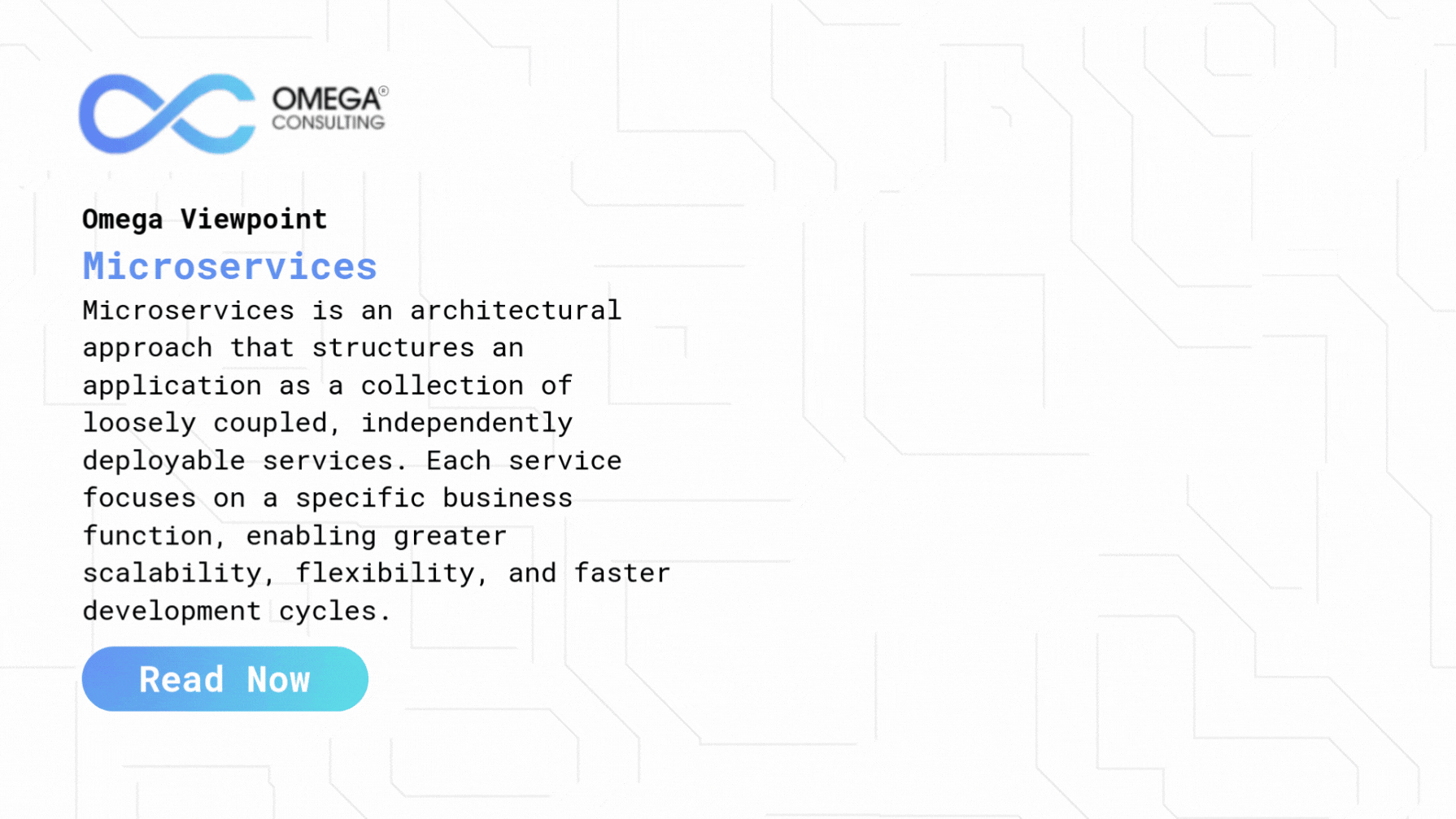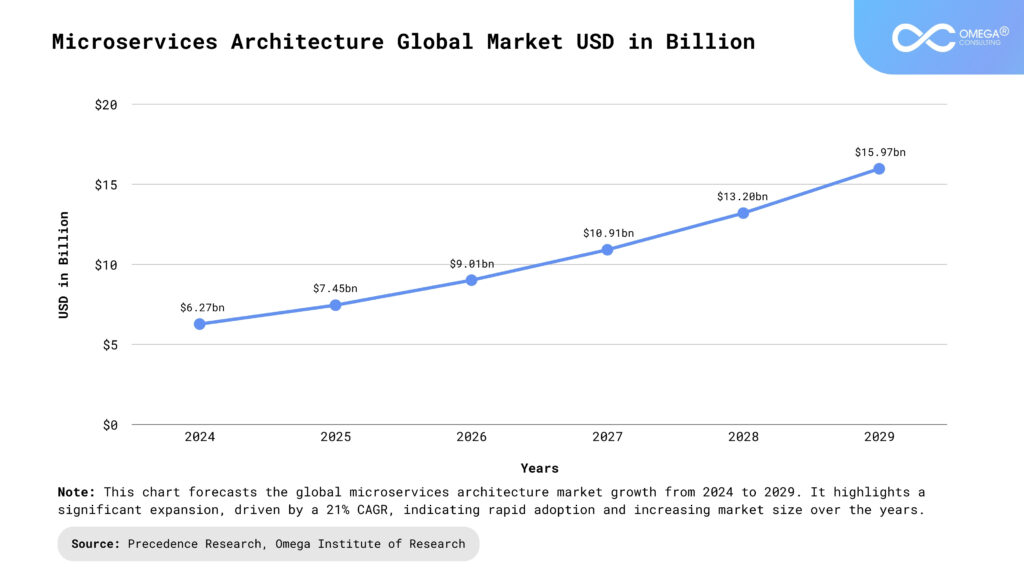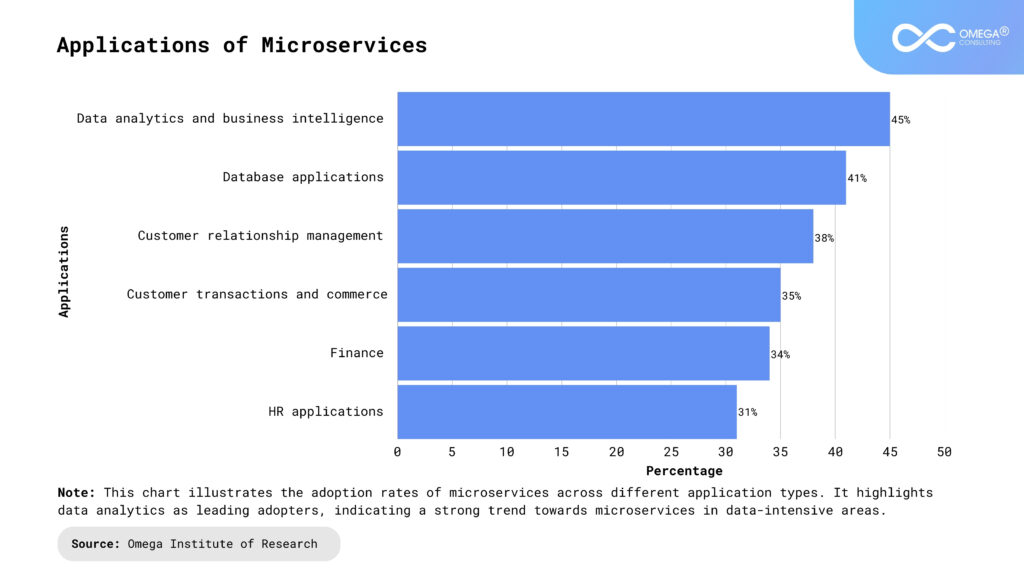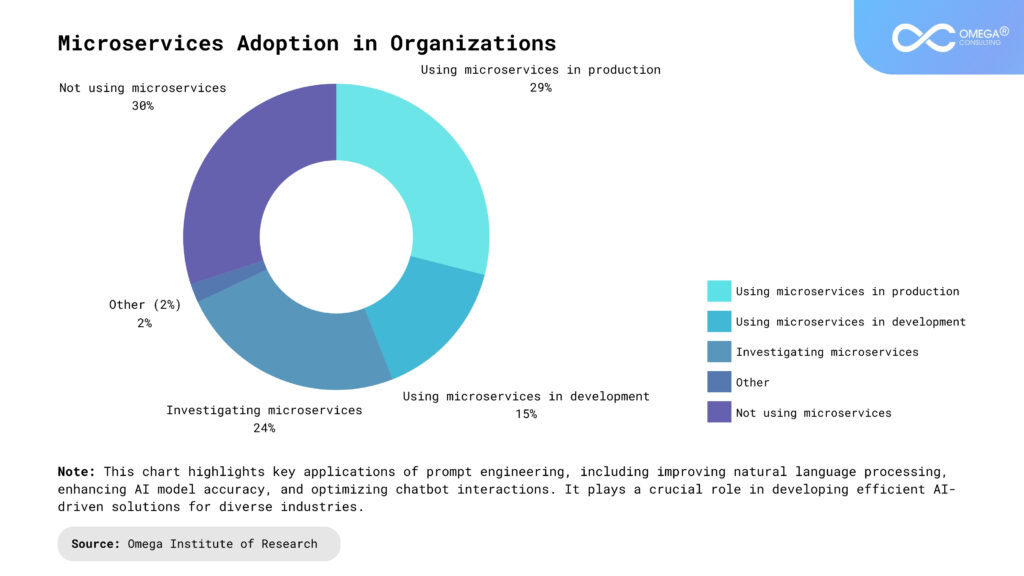- Industries
Industries
- Functions
Functions
- Insights
Insights
- Careers
Careers
- About Us
- Information Technology
- By Omega Team

Microservices offer a specific way of designing and organizing software development, changing the field significantly. This methodology involves constructing software applications as a collection of small, independent services that communicate via well-defined APIs. These services are typically managed by compact, self-contained teams, fostering agility and scalability within development processes. Utilizing a microservices architecture allows applications to scale more efficiently and evolve more rapidly, which in turn encourages innovation and significantly accelerates the time-to-market for new features. This approach stands in contrast to traditional monolithic architectures where tightly coupled processes run as a single service, making scaling and updates progressively complex and risky. This article explores the fundamentals of Microservices, including its key features, benefits, industry applications, challenges in deployment, and future trends, providing the individuals and businesses with knowledge to clearly understand microservices and apply them to foster their growth using Microservices.
What are Microservices?
A microservices architecture structures an application as a suite of independently deployable components, with each component operating as a distinct service. Communication between these services happens through well-defined interfaces, often using lightweight APIs. Each service is designed around a specific business capability and performs a singular function. This independence means each service can be updated, deployed, and scaled individually without impacting others. Unlike monolithic applications where scaling one function requires scaling the entire system and updates become cumbersome, microservices break down the application into decoupled, manageable parts. Microservices architectures are commonly adopted for cloud-native applications, serverless computing paradigms, and applications benefiting from lightweight container deployment. These services thrive in cloud environments, leveraging scalability and resource efficiency, and fit well with serverless models where infrastructure management is abstracted away.

Characteristics of Microservices
Autonomous: Each component service within a microservices architecture can be developed, deployed, operated, and scaled independently without affecting the functionality of other services. Services maintain autonomy by not sharing code or implementation details, interacting solely through well-defined APIs. This autonomy extends to separate codebases, build pipelines, and deployment schedules.
Specialized: Every service is purpose-built for a specific set of capabilities, concentrating on solving a particular problem effectively. This focus ensures that each service remains lean and performs its designated function efficiently. If a service starts getting too complicated over time, it can even be split into smaller, even more focused services to maintain focus and manageability, adhering to principles like the Single Responsibility Principle.
Benefits of Microservices
Agility: Microservices promote the creation of small, independent teams that own their specific services. Working within a clear, bounded context empowers these teams to operate autonomously and rapidly. Reduced communication overhead, focused scope, independent deployment pipelines, and the ability to make localized decisions significantly shorten development and release cycles. This directly boosts organizational throughput, allowing businesses to deliver more features faster and respond quickly to market changes or customer feedback.
Flexible Scaling: The architecture allows individual services to be scaled independently based on their specific resource needs and demand, without affecting other services. For instance, a computationally intensive recommendation engine can be scaled up during peak hours without scaling the user profile service. This granular scaling enables teams to optimize infrastructure usage efficiently, accurately track costs per feature or service, avoid over-provisioning, and maintain high application availability and performance even during demand surges by preventing resource contention.
Technological Freedom: Microservices avoid imposing a single, standardized technology stack across the entire application. Teams have the liberty to choose the most suitable programming languages, frameworks, databases, and tools for solving their specific service’s problems. For example, a team might use Python for a machine learning service, Java for a high-throughput transaction processing service, and Node.js for a service handling UI interactions. This flexibility not only leads to better technical solutions but also helps attract diverse talent specialized in different technologies.
Reusable Code: By dividing software into small, well-defined, and independently deployable modules (services), teams can reuse functions and capabilities across different features or even different applications. For example, a central authentication service can be leveraged by multiple front-end applications and other backend services, eliminating the need to reimplement authentication logic repeatedly. This promotes consistency, reduces duplicated development effort, and minimizes the potential for inconsistencies across the system.
Resilience & Fault Isolation: Service independence significantly enhances an application’s ability to withstand failures. Unlike monoliths where a single component failure can potentially crash the entire system (single point of failure), microservices isolate failures to the specific service experiencing issues. If a non-critical service like recommendations becomes unavailable, other core functionalities like browsing, cart management, and checkout can often continue operating normally. Implementing patterns like the Circuit Breaker can further enhance resilience by preventing repeated calls to a failing service and allowing it time to recover, thus preventing cascading failures across the system. This is much safer than monoliths, where one bug can crash everything.
Data Isolation: Each microservice typically manages its own private database or persistence mechanism. This means performing schema updates becomes much simpler and less risky, as changes are contained within the service’s boundary and don’t directly impact the data stores of other services. This contrasts sharply with monolithic applications where schema changes can be complex and hazardous due to multiple parts of the application potentially accessing the same shared database. It also allows teams to choose the most appropriate database technology (e.g., SQL, NoSQL, graph database) for each service’s specific data needs.
Applications of Microservices
The versatility and scalability of microservices architecture allow for its application across numerous industries and complex use cases, enabling large-scale, feature-rich platforms:
E-commerce: Leading platforms like Amazon and eBay heavily utilize microservices for distinct functions such as user authentication, product catalog management, inventory tracking, search functionality, personalized recommendations, shopping cart operations, order processing, and payment handling. This allows them to scale individual components (like payments during sales events) and rapidly innovate on specific features.
Streaming Services: Companies like Netflix and Spotify rely extensively on microservices to manage massive scale and deliver personalized experiences. Separate services handle user accounts, billing, content discovery and cataloging, personalized recommendations, streaming delivery across various devices, digital rights management (DRM), and playback state synchronization.
Financial Services: The finance industry employs microservices for core banking operations, high-frequency trading platforms, transaction processing, fraud detection systems, risk management analysis, and customer account management. Payment gateways like Stripe and PayPal use microservices to ensure scalable, secure, and reliable payment processing globally. The isolation helps meet stringent security and regulatory compliance requirements (like PCI DSS).
Travel and Hospitality: Online booking platforms (like Expedia or Booking.com) use microservices to manage complex inventories and integrations. Separate services handle flight searches, hotel reservations, car rentals, dynamic pricing engines, user reviews, loyalty programs, and notification systems (email/SMS alerts).
Healthcare: Microservices can modernize and enhance Electronic Health Records (EHR) systems and other healthcare platforms. Individual services can manage patient demographics, appointment scheduling, clinical notes, prescription management, medical imaging, billing, and integration with third-party diagnostic tools or insurance providers. This improves interoperability, scalability for growing patient data, and helps address compliance requirements like HIPAA through better data isolation and access control.

Challenges in Microservices
Complexity: While individual services are simpler, the overall system involves more moving parts compared to an equivalent monolith, increasing systemic complexity, particularly around inter-service communication, distributed transactions, and managing dependencies.
Lack of Governance: The decentralized nature, while advantageous, can lead to an unmanageable proliferation of languages and frameworks without project-wide standards, potentially complicating maintenance and increasing technical debt, especially for cross-cutting concerns like logging and monitoring.
Network Congestion and Latency: Increased interservice communication, often over a network, can introduce latency and potential points of failure. Long chains of synchronous service dependencies can amplify these issues, requiring careful API design, consideration of asynchronous patterns, and robust network infrastructure.
Data Integrity: With each microservice managing its own data persistence, ensuring data consistency across services becomes a significant challenge. Transactions spanning multiple services often rely on complex patterns like sagas and eventual consistency (BASE model) rather than simpler traditional ACID transactions.
Management: Success requires a mature DevOps culture and sophisticated tooling. Tasks like distributed tracing, aggregated logging across multiple services for a single user request, and managing complex deployment pipelines can be difficult without the right practices and infrastructure.
Versioning: Service APIs evolve, and updates must be carefully managed to avoid breaking downstream consumers. This necessitates robust strategies for API versioning, backward compatibility, and potentially managing multiple versions of a service concurrently.
Best Practices for Microservices
Decentralize Design: Empower autonomous teams to own the full lifecycle of their service(s), from design and development to deployment and operation. This aligns with Conway’s Law and fosters faster decision-making and accountability within clear boundaries.
Keep Data Storage Private (Database-per-Service): Each microservice should manage and own its database(s), accessible only via its API. Avoid direct database sharing between services, as this creates tight coupling, hinders independent schema evolution, and limits technological flexibility. This practice ensures data encapsulation and service autonomy.
Use Appropriate Storage Technologies: Recognize that different services have different data storage needs (e.g., transactional integrity, document flexibility, read performance, caching). Select the database technology (SQL, NoSQL variants like document, key-value, graph, etc.) that best fits the specific requirements of each service, rather than forcing a single solution.
Communicate via APIs: APIs are the contracts between services. Design them thoughtfully around business capabilities, ensuring they are clear, consistent, and hide internal implementation details. Prioritize stability and use versioning strategies to manage changes gracefully, preventing breaking downstream consumers. Common choices include RESTful HTTP APIs or gRPC.
Keep Domain Logic Out of API Gateways: API Gateways should primarily handle cross-cutting concerns like request routing, authentication/authorization, rate limiting, and basic request/response transformations. Avoid embedding complex business logic specific to a domain within the gateway, as this creates a potential bottleneck, obscures service boundaries, and increases the gateway’s complexity.
Ensure Loose Coupling: Design services to minimize dependencies on each other. Services should interact through well-defined APIs without needing knowledge of the internal implementation details of other services. Loose coupling makes the system more resilient and allows services to be changed, replaced, or scaled independently.
High Functional Cohesion: Each microservice should focus on a single, well-defined business capability or domain. Avoid creating services that handle too many unrelated responsibilities. High cohesion makes services easier to understand, develop, test, maintain, and reuse.
Future of Microservices
Increased Adoption of Serverless Computing: Serverless platforms (like AWS Lambda, Azure Functions, Google Cloud Functions) align perfectly with the microservices philosophy. They allow developers to deploy code as individual functions (Functions as a Service – FaaS) without managing the underlying infrastructure. This enables even finer-grained decomposition than traditional microservices, automatic scaling based on demand, and a pay-per-use cost model, significantly reducing operational overhead and allowing teams to focus purely on business logic.
Enhanced Service Mesh Capabilities: Service meshes (like Istio, Linkerd, Consul Connect) are becoming increasingly sophisticated, abstracting complex network concerns away from the application code. Expect maturation in areas like advanced traffic management (e.g., fine-grained canary releases, A/B testing, fault injection), zero-trust security models (e.g., automatic mutual TLS), and deeper observability (e.g., distributed tracing, golden signal monitoring). As these tools become easier to use and more powerful, they will be critical for managing the complexity of large-scale microservices deployments reliably and securely.
Growth of Event-Driven Architectures (EDA): Asynchronous, event-driven communication patterns are gaining traction within microservices ecosystems. Instead of direct synchronous requests, services communicate by producing and consuming events via message brokers (like Kafka, RabbitMQ, Pulsar). This decouples services more effectively, improves resilience (as services don’t need to be available simultaneously), enhances scalability, and facilitates better handling of real-time data streams and complex workflows. EDA is becoming a cornerstone for building responsive and robust distributed systems.
AI and Machine Learning Integration: Microservices provide a natural architecture for deploying and managing AI/ML models. Dedicated services can encapsulate specific ML models, making them easily accessible via APIs. Furthermore, AI/ML will be increasingly integrated into the microservices platform itself for intelligent automation (e.g., predictive auto-scaling based on anticipated load), smarter traffic routing, anomaly detection in monitoring (AIOps), automated security responses, and delivering personalized user experiences through recommendation engines or chatbots powered by specialized microservices.
Edge Computing: As computing moves closer to the data source (the “edge”) for applications like IoT, autonomous vehicles, and real-time analytics, microservices offer a flexible way to deploy specific functionalities to edge devices or local gateways. This architecture allows for processing data locally, reducing latency, saving bandwidth, and improving responsiveness for applications requiring near-instantaneous feedback. Lightweight containerization and serverless functions at the edge will likely leverage microservice principles.

Conclusion
Microservices architecture provides a powerful approach for building scalable, resilient, and rapidly evolving applications. By breaking down complex systems into smaller, independent, and specialized services, organizations can achieve greater agility, technological flexibility, and improved fault isolation. While challenges related to complexity, data consistency, and management exist, adhering to best practices and leveraging modern platform tools like container orchestrators, service meshes, and event-driven patterns can effectively mitigate these issues. As cloud computing, serverless, AI, and edge technologies continue to advance, microservices will remain a central paradigm in developing sophisticated, distributed, and intelligent software solutions for the future, enabling businesses to innovate faster and adapt to changing market demands.
- https://martinfowler.com/articles/microservices.html
- https://docs.aws.amazon.com/prescriptive-guidance/latest/modernization-data-persistence/database-per-service.html
- https://learn.microsoft.com/en-us/azure/architecture/guide/architecture-styles/microservices
- https://foojay.io/today/microservices-design-principles-for-well-crafted-architecture/
- https://www.leanix.net/en/wiki/trm/microservices-governance
- https://www.solo.io/topics/api-gateway/api-gateway-microservices
- https://net2.one/microservices-geeks-hype-or-real-benefit-for-your-business/
Subscribe
Select topics and stay current with our latest insights
- Functions